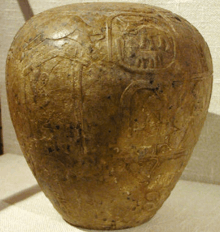Narmer Macehead

Centre left: Pharaoh Narmer seated in a naos
The Narmer macehead is an ancient Egyptian decorative stone mace head. It was found during a dig at Kom al Akhmar, the site of Hierakonpolis (ancient Egyptian Nekhen). It is dated to the Early Dynastic Period reign of king Narmer (c. 31st century BC) whose serekh is engraved on it. The macehead is now kept at the Ashmolean Museum, Oxford.
Motifs
The Narmer macehead is better preserved than the Scorpion Macehead and has had various interpretations. Now the opinion is, as for the Palette, that the events depicted on it records the year it was manufactured and presented to the temple, a custom which is known from other finds at Hierakonpolis,[1] rather than great occasions like Narmer's Heb Sed festival or marriage to a possible Queen Neithhotep, a theory of earlier scholars, among them Petrie and Walter Emery.[2]
On the left side of this macehead we see a king wearing the Red Crown (deshret) sitting under a canopy on a dais, covered in a long cloth or cloak. He is holding the flail and above the canopy a vulture hovers with spread wings, possibly Nekhbet, the local goddess of Nekhen, the religious and political capital of predynastic Upper Egypt. Directly in front of him is another dais or possibly litter on which sits facing him a cloaked figure. This figure has been interpreted as a princess being presented to the king for marriage, king's child [1] or a deity. The dais is covered by a bow-like structure and behind it are three registers. In the center register attendants are walking or running behind the dais. In the top register an enclosure with what seems like a cow and a calf might symbolise the nome of Theb-ka, or the goddess Hathor and her son Horus, deities associated with kingship since earliest times. Behind the enclosure four standard-bearers approach the throne. In the bottom register, in front of the fan-bearers, are seen what looks like a collection of offerings.
On the center part of the macehead, behind the throne with the seated king there is a figure just like the supposed sandal-bearer from the Narmer palette, likewise with the rosette sign above its head. He is followed by a man carrying a long pole. Above him three men are walking, two of them likewise carrying long poles. The serekh displaying the signs for Narmer can be seen above these.
The top field to the right of the center field shows a building, perhaps a shrine, with a heron perched on its roof. Below this, an enclosure shows three animals, probably antelopes. This has been suggested as signifying the ancient town of Buto, the place where the events described on the macehead might have taken place.
External links
| Wikimedia Commons has media related to Ancient Egyptian maceheads. |
| Wikimedia Commons has media related to Narmer. |
References
- 1 2 Millet 1991.
- ↑ Walter B Emery, Archaic Egypt, Pelican Books,1961, ISBN 0-14-020462-8
Bibliography
- Millet, N. B. (1991). "The Narmer macehead and related objects". Journal of the American Research Center in Egypt. 28. doi:10.2307/40000073.
- Yurco, F. J. (1995). "Narmer: First king of Upper and Lower Egypt. A Reconsideration of his palette and macehead". Journal of the Society for the Study of Egyptian Antiquities. 25.